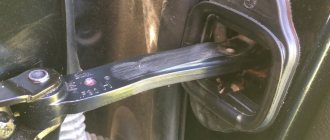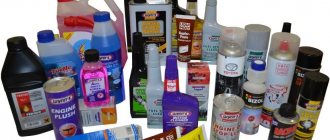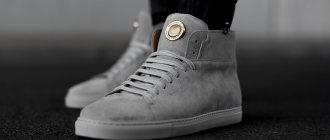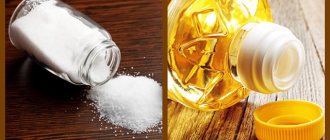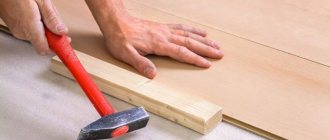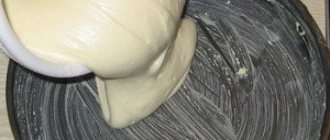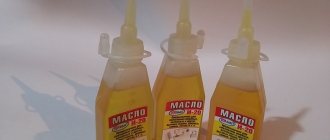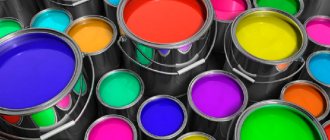The creaking of door hinges accelerates their wear and is very irritating to the ears and nerves. With proper care of the door fittings, the structure will remain suitable for use longer. And inaction in such a situation in the future will lead to breakage and replacement of the hinges. It is much easier and cheaper to take care of them in a timely manner. Regular lubrication will help avoid problems and extend their service life for a longer period.
Reasons for squeaking on door hinges
The most common causes of creaking hinges are the following:
- Incorrect fastening of hinges when installing the door.
If this is the reason, the creaking appears immediately after installing the door and starting to use it. In the case of hinges on an iron entrance or street door that were welded before its installation, you are unlikely to be able to do anything yourself, so you should contact specialists to reinstall the hinges - for example, those who installed this door for you.
As for interior doors, in order to prevent the possible occurrence of creaking in the future and save yourself from the problems of removing and lubricating the door, you can install a new door while observing one nuance. To do this, half-hinges with an axle (pin) can be attached to the door leaf, and half-hinges with a hole similar to a cup can be attached to the door frame, while usually everything is done exactly the opposite, which leads to rapid leakage of oil when lubricating the door.
- The hinges and door trim touch each other.
In this case, in order to remove the creaking, you will have to be careful and adjust the dimensions of the cladding to specific hinges.
2. Lack of lubrication in the hinges, or the use of an inappropriate lubricant.
3. Lack of special balls in the hinge design.
There is only one way out: you will have to remove the doors and the hinges from them, which are then completed with the missing balls, after which the hinges are reattached to the door leaf, and it, in turn, returns to its rightful place.
That is, it is not so difficult to eliminate the cause of a door squeak, the main thing is to diagnose it correctly.
Application rules
Please note that you do not need to apply a large amount of lubricant to the hinges. Of course, it won't make them any worse.
The point is different. That part of the composition that was superfluous flows down the doors and further onto the thresholds. As a result, the lower part of the body is covered with a continuous greasy film. Naturally, it will “magnetize” all the road dust. Within a week, the effect of such treatment will be shocking for the car owner - black sills and parts of the doors with a thick layer of road dust. Regular washing will not eliminate this - you will need the help of a rag. And scratching the paint on the body, removing all this plaque, is a very unpleasant task.
The hinges of modern cars have a special cap that is locked into the door pin; it is into this that the lubricant should be poured. The cap will not allow it to come out (of course, if the volume of lubricant was normal). To distribute the product evenly across the hinges, it is necessary to open and close the doors several times.
The door is creaking, what should I do?
Very often, doors begin to creak immediately after installation. Usually a few days pass, and apartment owners experience unpleasant noise. In this case, this is due to improper installation of the door leaf. It is necessary to call a repair team to ensure that they adjust the door correctly. If, in addition to hearing a creaking sound, it is difficult to open the doors, then sagging of the door leaf is to blame.
The door creaks, what to do:
- For these purposes, it is necessary to use an eccentric and correctly center the front door. You will need a special key. Very often there are problems with the lock if the door sag. In this case, it is necessary to urgently adjust it, because this can lead to damage to the lock.
- You simply won't get into the house because it's jammed. Please note that often door hinges and their component parts fit tightly together. This makes it impossible to pour lubricant into it. Try using other methods.
- To do this, you need to lift the door by about 1-2 cm, so that a gap is formed. Next, lubricant must be introduced into this gap. This could be machine oil or grease. Solid oil is applied with a thin stick. If you don't find anything in your house, you can use a regular pencil lead. It is necessary to grind it with sandpaper or a knife until dust is obtained. It is this dust that is found in the space between the hinge parts.
Door creaking
Preventative care
After installing an interior door, it requires regular maintenance. Experts advise doing this:
- The door must be varnished annually. This will prevent rapid wear, loss of appearance and physical characteristics of the canvas.
- Scratches, dents, and abrasions that have arisen can be eliminated as follows: moisten the damaged surface, carefully sand it with very fine sandpaper and carefully rub in furniture wax or polish until a shine appears. If the damage is significant, treat the entire door leaf so that the surface is free of streaks and stains.
- If the canvas is glass, then it must be wiped from contamination with solutions without aggressive components.
AttentionDo not use abrasive cleaning powders, as they will ruin the appearance of the canvas.
- Any repair of a door leaf must begin with its removal.
- Take care of locks and latches once every 1–2 years. Pull out all the crossbars, clean them of dirt, lubricate them, as well as the hinges, tighten all the fastening screws. In general, of course, it is better not to take risks and entrust the locks to professionals, for example, the company that performed the installation.
- Constantly wipe the surface from dust and dirt. When dirty, clean handles and locks with a cloth and soap.
- Do not abuse water or other liquids when cleaning; carefully remove excess moisture with a dry cloth.
- Before any repairs in the apartment, the door frame must be protected with covering material to prevent dirt from getting inside the latches, hinge mechanisms and locks.
- All elements must be periodically lubricated with oil so that they do not rust and rotate freely when opening and closing.
When an interior door creaks, you need to identify the cause of this phenomenon. Then you can begin to fix the problem by adjusting the hinges or lubricating them with improvised means - Vaseline or machine oil.
How to lubricate a squeaky door
In order to lubricate door hinges, you can use both folk and special means. The following are usually used as folk remedies:
- vegetable oil;
- pencil lead;
- warm melted paraffin or wax.
Although these remedies are very affordable, they should be used only in extreme cases, and then with caution, since each of these remedies has certain disadvantages. Thus, warm wax and vegetable oil have a short-term effect, and therefore they are best used in emergency cases. In addition, vegetable oil used as a lubricant for hinges quickly becomes dirty. This also applies to various food fats, butter or petroleum jelly - they all quickly become dirty, contribute to corrosion on the metal, and they only get rid of squeaking until they dry out.
Therefore, if you have already used one of these home remedies to get rid of the squeaking hinges of a plastic or wooden door, it is still highly advisable to purchase a specialized lubricant as soon as possible. Just before lubricating the hinges, you need to remove previously used vegetable or any other “homemade” oil from them.
How are furniture hinges processed?
If the reason is that the oil in the part has dried out and does not allow it to function fully. You need to lubricate the hinges with a special substance. Suitable for this:
- Solid oil;
- Oil lubrication;
- WD-40 spray (available at automotive stores)
When there are no special means at home, you can use improvised means:
- Sunflower oil.
- Coconut oil.
- Petrolatum.
- Cream.
- Paraffin.
- Soap.
The main thing is that the substance is slippery and greasy. The means at hand will help get rid of squeaking for 1-2 weeks. Choose special oils for furniture hinges or lubricants. They penetrate deep into crevices and ensure long-lasting operation of furniture.
Various types of lubricant
Lubricating door hinges is the first thing you can do against annoying squeaking noises. You can use both industrially produced lubricants and improvised home remedies.
But it should be remembered that only properly selected lubricant will have a long-term and effective effect.
Universal means
Well-known and affordable products that are easy to buy in a store or find in your garage:
- WD 40 - comes in a can with a convenient dispenser, allowing you to easily reach hard-to-reach places. A very effective product that cleans the surface and improves the sliding of parts. It works instantly, but not for long. You must use oil afterwards.
- Litol - due to its pronounced water resistance and frost resistance, it is widely used for lubricating entrance doors and gates. Not afraid of adverse weather conditions.
- Solidol is a popular inexpensive product, the effect of which will last for a long time. The reason for this is the thick and viscous consistency of the lubricant.
Machine oil
Ordinary machine oil is a good lubricant for door hinges. Almost every household has a bottle of this technical liquid.
Car owners always have waste - oil left after replacing it in the car with a new one. Oil for engine or car parts is also suitable. It is better to choose one whose viscosity is higher.
Sewing machine oil
Handicraft workers will most likely have oil for sewing machines on their households. A small plastic container with a thin spout will allow you to place a drop of oil exactly where you need it. Sewing machine oil is usually light in color and does not leave a dirty residue.
Vegetable oil
As a last resort, you can take vegetable oil from the kitchen. A short-term effect will be achieved, but some negative consequences are also possible.
Vegetable oil is too liquid, it spreads a lot and dries out quickly. Also, a lot of dust and dirt sticks to it, which leads to wear of the mechanisms. Over time, such oil can darken and thicken, which leads to damage to the fittings.
Pencil lead
An alternative to oil is dry graphite lubricant. The door is lifted and small pieces of pencil lead are placed in the hinges. When opening and closing the door, the stylus crumbles, and the resulting powder prevents squeaking. An easier way to use is to pour crushed stylus into the cracks of the hinges.
Paraffin or wax
Candles made of wax or paraffin are sure to be found in every home. A piece of the substance is heated to a liquid state and buried inside the creaking mechanism. When cooled, the wax hardens and forms a smooth sliding surface.
Causes
It is important to take into account not only the condition of the door structure, but also its purpose. The reasons for unpleasant sounds will differ dramatically when comparing entrance and interior doors. The opening/closing mechanism, the presence of decorative and auxiliary elements are also taken into account. Even the method of fastening and fittings play an important role. Therefore, all points must be taken into account. The following analysis will allow you to determine not only the causes of the problem, but will also help you choose the best way to lubricate the door so that it no longer creaks.
What types of lubricants should you avoid?
Even if a squeaky door is very annoying, there is no need to try to lubricate it with the first grease you come across. It is highly undesirable to use organic substances - lard, butter and vegetable oil. They contain a large amount of water, which will interact with the metal and cause its slow corrosion.
Over time, this will only make the squeak louder. Also, animal fats quickly decompose, they can even become moldy.
The popular product WD 40 should also be used with caution. It is not so much a lubricant as a washing composition. It cleans the mechanism of dirt, but at the same time washes away the old lubricant. The quick effect of the first application will be replaced by worsening problems. Therefore, after using WD 40, it is recommended to lubricate the hinges with a thicker lubricant.
How to deal with creaking metal doors?
Modern doors are made from different materials, and this matters in this matter.
For metal doors, of course, machine oil and other specified compounds will also be effective, but only if the metal product creaks due to friction of the hinge components.
However, an annoying sound may also be a consequence of the fact that the awnings were installed incorrectly when installing the door. In this case, especially if the structure is an entrance one, there is only one option - contact a professional installer. It is unlikely that you will be able to fix everything on your own, without special knowledge and skills.
Features of lubrication of various types of doors
Having decided how to lubricate the door hinges, all that remains is to do it correctly. The methodology for performing work is influenced by many factors: material, location, design.
Iron door
Usually it starts to “sing”, sagging due to the heavy canvas and corrosion. Iron doors, as a rule, are street entrance doors; they are predominantly all-welded, non-demountable structures. They will have to be processed on site without removing them. You just need to select a strong stop to lift the sash.
First you need to clean the fittings from dirt and rust, and lubricate them in places where the metal rubs - between moving elements.
Be sure to wipe off leaked residues, and then open and close the door several times to distribute the substance along the internal hinges.
Plastic
Mostly indoor, but sometimes balcony. In the latter case, the sash from the street is first processed, and then from the side of the room.
The open door needs to be lifted slightly using a stop. Apply a small amount of oil and close the cloth.
Important : stains from grease are very noticeable on white plastic, which is not visible immediately, but some time after the procedure. It is preferable to make a test in an inconspicuous place before “treating” the door and observe the reaction of the material to the substance.
Wooden
Installed mainly in apartments and between rooms. The procedure is carried out according to the generally accepted scheme, but is simplified by the fact that some models can be easily disassembled, providing access to the fittings. Otherwise, lubricant is introduced into the gaps on the hinges.
Important : it is better to protect natural wood from contact with chemicals, as deformation may occur or a stain may remain.
Glass
Despite the apparent airiness, such a door is very heavy, which is why the design uses special hinges with rubber seals. During installation work, this place is treated with glue to increase reliability and extend service life.
This feature does not eliminate grinding and creaking, and does not interfere with lubrication, but it is better to be aware of it when planning to carry out processing.
Important : oil cannot be washed off glass, so it is recommended to use WD-40.
Accordion door
Easy to understand, but requires a thorough approach:
- cleaning the groove and wheels from anything that has stuck during the door operation;
- lubrication of all moving elements.
But the latter is performed exclusively with a special silicone agent. Only the rubbish will not stick to it.
Sliding door
Most often it makes noise not because of poor lubrication, but because of debris that accumulates in all possible places. Some hardened deposits can be cleaned with a wire brush, and other debris can be cleaned with a vacuum cleaner.
Important : to make the wheels move more easily, apply silicone lubricant after cleaning.
How to do it
The process of lubricating the hinges should be carried out carefully and carefully so as not to pinch your fingers. Do not lubricate without gloves and special tools.
For example, grease can be applied with a wooden stick. And it is most convenient to pour machine oil into the gaps between the hinges using a syringe. It can also be used to remove rust on hinges.
In order for the hinge lubrication procedure to have the best result and last for a sufficiently long time, it is recommended to remove the doors before lubrication. Apply the product to the hinges, generously lubricating the upper part of the hinge, and at the end of the work, put the canvas in place. Then it is recommended to open and close the door several times so that the lubricant is evenly distributed along the entire length of the hinge.
If your interior door design is not collapsible, then the hinges need to be lubricated without removing the door leaf.
Basic rules when applying lubricant:
- Open the door as far as possible.
- Raise the canvas by placing a heavy object under the end.
- Remove lubricant residues, dust and dirt.
- Using special tools, apply new lubricant around the perimeter of the hinges. To apply it, you can use a syringe, thin brush or stick.
- When closing and opening doors, distribute lubricant evenly on the hinges.
- Remove any remaining oil with a dry cloth.
It is recommended to lubricate the upper part of the hinges very generously, since the main pressure occurs on it during operation.
By periodically carrying out simple procedures for lubricating moving parts and inspecting your doors, you can prevent the occurrence of squeaking.
How to use specialized tools to eliminate squeaks
How to lubricate the hinges of interior doors and what is required for this? Let's try to figure it out. First of all, you need to prepare:
- lubricant: oil, spray and so on;
- a dry and clean cloth;
- door removal tool. You can use an axe, crowbar, or other device that creates leverage.
If the hinges on the doors creak, then to eliminate it you need to take the following steps:
- remove the door from its hinges. To ensure that the procedure does not cause difficulties, the door leaf should be lifted slightly using an ax or crowbar. In this position, the loops will easily separate;
Removing the door from its hinges
- a lubricant is carefully applied to all hinge elements located on the door leaf and frame;
Lubricating door hinges
- the door is hung on hinges;
- several opening and closing cycles are performed to more evenly distribute the lubricant over the surface of the hinge;
- Remaining oil is removed with a dry cloth.
Removing residual oil
It is recommended to carry out work on lubrication of hinges with gloves that protect the skin of the hands from negative effects.
Now let’s figure out how to eliminate the creaking of universal hinges, that is, one-piece hinges. To do this, lubricant is simply applied between the hinge hinges without removing the door leaf.
Lubrication of universal one-piece hinges
To process permanent hinges, it is more convenient to use sprays or aerosols.
Lubricating the hinges
You can lubricate the hinges directly on the existing door. But in order to better access the internal surfaces, it is recommended to remove the door.
Without removing the door
If the creaking is light and the mechanisms are not very worn, then it is much easier to lubricate the door without removing it from its hinges. The lower edge of the canvas is raised with the help of a stop, and the upper part of the loop comes out of the socket.
It becomes possible to introduce lubricant inside through the resulting gap. This is done with a syringe without a needle or directly from a can using a narrow nozzle. When finished, you need to open and close the sash several times to make sure the creaking disappears.
It is recommended to cover the surface of the wall and the canvas around the loop with film. Contamination from lubricants is very difficult to wash off.
Taking the door off its hinges
The hinges on the removed door can be subjected to deeper and more thorough processing. To remove the door, you do not need to lift it slightly, but move it upward until the inner parts of the hinges come out of the recesses. Then the rust is removed from the metal and treated with a degreasing compound. The hinges are lubricated over the entire surface with thick grease, and the excess is wiped off with a rag.
Lubricant for hammer drills is considered the most reliable. This treatment will give a durable and stress-resistant result.
Input
The front door protects the house from intrusion by uninvited guests and most often its body is made of metal. Causes of unpleasant sound and methods for eliminating problems:
| Problem | Solution |
| Incorrect installation of the device | Carry out dismantling and check the result |
| Blade offset | Checking the condition of the hinges |
| Dirt, debris, and metal corrosion were found in the hinges | Cleaning. Dry with a hairdryer. Lubrication. WD-40 aerosol will help against corrosion |
| The door doesn't close or open well | Remove the structure and check the condition of the hinges. Carry out lubrication procedures. |
If the structure is sagging or the sound is associated with friction, then there will be characteristic marks on the canvas between the opening and the door.
